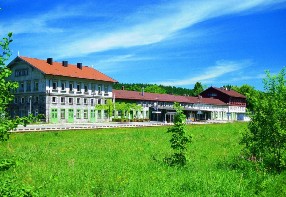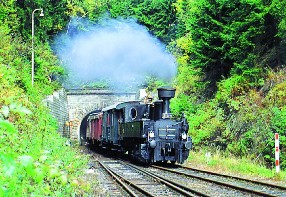RAILWAY POINTS OF INTEREST
There are six railway stations and two tunnels along the Plzeň-Železná Ruda railway line in the Železná Ruda area, which was connected to the Eastern Bavarian Railway in 1877. Moreover, Deutsche Bahn operates some daily services to Špičák station on the line from Zwiesel, Germany.
Shared Czech-Bavarian railway station of Železná Ruda – Bayerisch Eisenstein in Alžbětín
You will find a tourist information office for the Bavarian Forest and Šumava inside the railway station, together with an interesting interactive map of the entire Šumava and Bavarian Forest region. Nearby, on the Bavarian side of the border, is a railway museum, which includes displays of twenty historical carriages (www.localbahnverein.de, tel.: +49 99251376. Variable opening hours: please see WebPage for more details).
The history of the train station is interesting as well as educational. The new building was opened jointly by the Austrian Emperor and his Bavarian royal counterpart on 20th October 1877 as the “Eisenstein changing post’, as it was called in the state contract of 1873. This document also set out a still-existing rarity of the train station: ‘Eisenstein station shall be established in such way that the border divides the building into two halves’. Thus the formidable symmetrical building, with two two-storied wings and a connecting middle section, built by the workers of the Bavarian Eastern Railway, is still split down the middle by the state border, as is the railway track. The train station survived the war and its final stages, with the first Czechs arriving at the shared train station in Železná Ruda-Alžbětín from Nýrsko as early as 2nd June 1945.
The first postwar years in this part of Šumava saw an increase in the amount of freight transport going westwards from Czechoslovakia. However, this period also saw a new feature, unheard of in Železná Ruda-Alžbětín: the railway was divided along the border by wooden barriers placed there on the orders of the American army. After 1948, the entire area was declared closed, ending public transport in the area. The border station of Železná Ruda-Alžbětín was closed down, the Czech ticket office was bricked up and the building, as well as the train station, were blocked off, this time by a much stronger barrier than the American one. This resulted in a notorious border area. Passenger transport terminated in the station of Železná Ruda-město, from whence trains returned to Špičák station.
Discussions about reopening the border station of Železná Ruda-Alžbětín were held already prior to November 1989; however, nothing came of them. Then at the end of 1989, events moved more quickly: following the signing of an official agreement in April 1990, it took only one year to reconstruct the railway and the shared border station. The prime ministers of both countries then gave the green light to the restarting of train operations on 2nd June 1991. The reconstruction of the Bavarian part of the railway station is currently underway.
Špičák Railway Tunnel, 1,747 m
The railway from Plzeň to Železná Ruda was opened in the 1870s with the intention of improving commercial links between the Czech lands and Bavaria, and mainly the transport of coal from mines in northern Bohemia. Several tunnels were built through the Šumava massif. The track passes through a 1,747 metre-long tunnel beneath the Špičák valley, between the stations of Brčálník and Špičák. The tunnel was built between 1874 and 1877 and was one of the first railway tunnels in the then Austria-Hungarian Empire. To this day it remains the biggest of its type in the Czech Republic.
There are three more tunnels along the Plzeň-Železná Ruda railway line. The first of the three tunnels is 165 metres long and is located between Dešenice and Zelená Lhota stations. The second is the aforementioned Špičák tunnel. The last tunnel, measuring 198 metres, leads directly below the part of Železná Ruda between the Železná Ruda-mesto and Železná Ruda-centrum stations.


